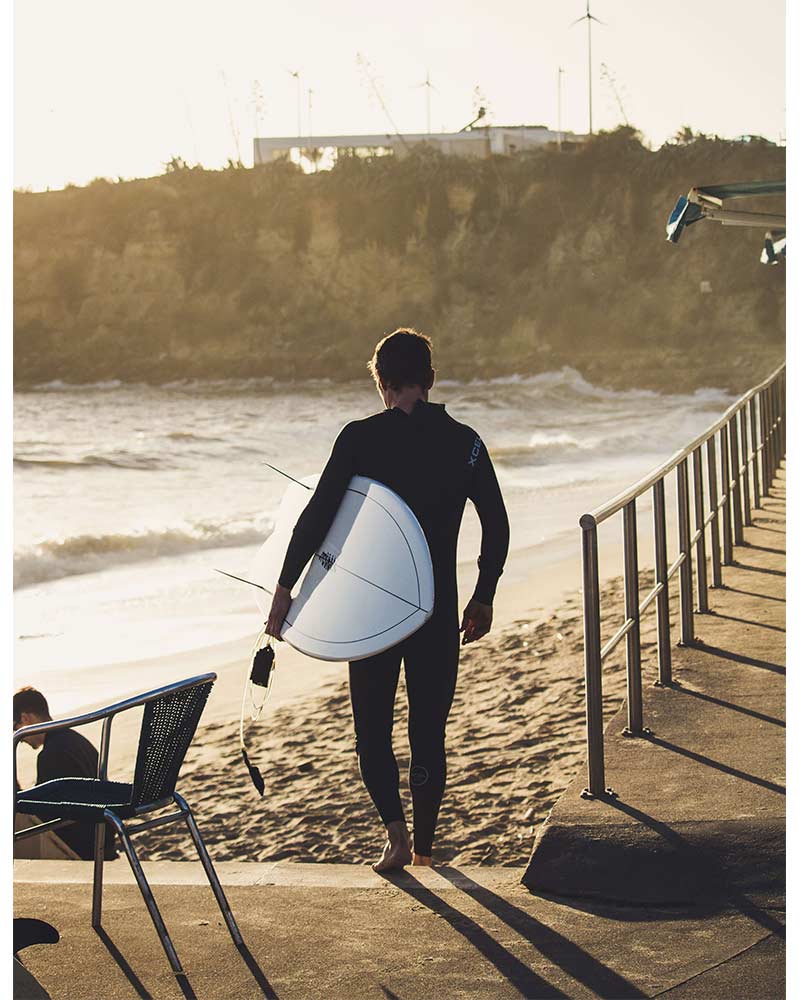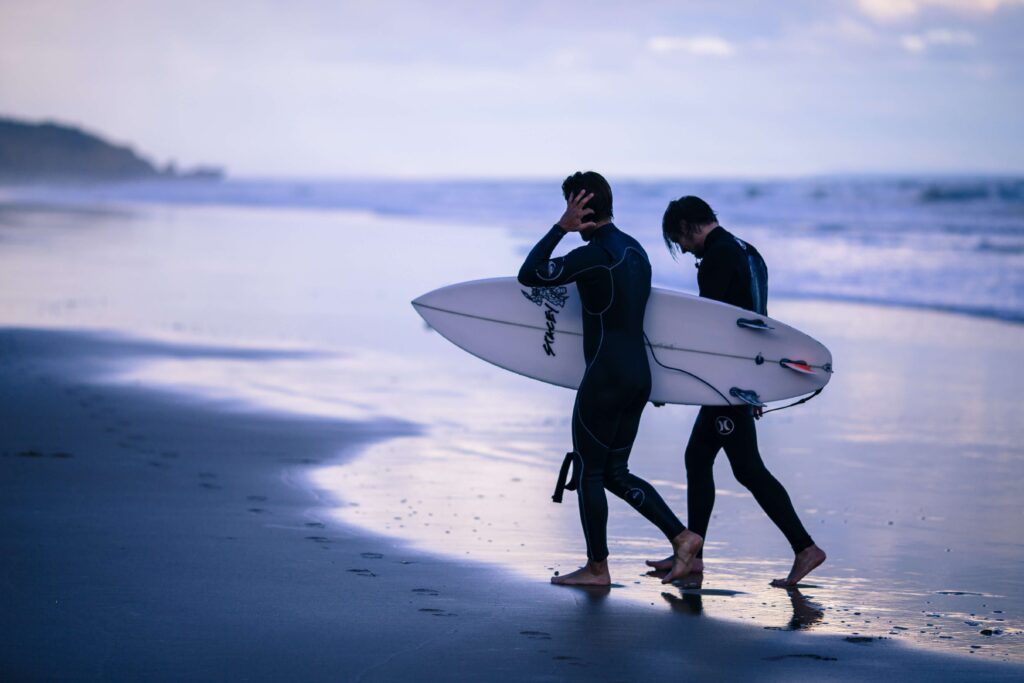Top 10 Surfing Tricks You Should Know
Samuel Johnson July 7th, 2021 Posted In: Articles Tags: Surfing
Surfing can be a great deal of fun and also a source of frustration at times. Here are some surfing tricks that I wish I knew before my first attempt at this fun-filled water activity. Let’s get into the top 10 surfing tricks you should know!
Top 10 Surfing Tricks You Should Know
- Bring a friend or find an instructor
- Pick the right surfboard
- Wear protection
- Location and water conditions
- Take a look at the weather report
- Wax on, wax off
- Keep it on a leash
- Learn to fall
- Surfing etiquette
- Have fun!

1. Bring a friend or find an instructor
All fun aside, surfing can be dangerous. Bring a buddy when you go into the water. Having someone who knows you nearby in an emergency can save your life! You will fall off the board many times and even professional surfers can get injured periodically. Plan ahead and bring someone who can look out for you and vice versa. You could always take a water survival or rescue course that can teach you how to save someone and provide emergency aid. They can help make you more comfortable in the water too. SCUBA diving centers often teach courses like these too.
You may also want to hire an instructor to teach you how to surf! Be careful with who you choose for this role and make sure they are someone you trust. Take the time to check their credentials and perform your due diligence.
2. Pick the right surfboard
Beginners can be easily overwhelmed by the amazing variety of surfboards to buy or rent. You may be tempted to choose a smaller board that looks more manageable. Avoid this temptation and choose a larger board to practice with. You can find out a great deal from a beginner’s surfing class. My first surfing attempt involved renting a small board and trying to take on some large waves which ended poorly. A larger longboard or funboard and smaller waves to practice on would have been a better choice for my first time. Better yet, I should have gone with someone who knew how to surf that could advise and mentor me. Pay a coach if you have to, that knowledge is worth it from the right teacher.
Tired of waiting for waves? You could take off on the LIFT eFoil electric hydrofoil surfboard available through the Wetsuit Wearhouse! We also offer demos and lessons on the Potomac in Western Maryland for those in the area.
3. Wear Protection
Playing in the waves and water can be fun to the point where we forget to drink enough water. People often stay in the sun too long without the proper protection. Dehydration, heat stroke, cramps, sunburns, hypothermia, and other problems you don’t want to deal with become more likely as time passes out on the ocean. Many surfers wear rash guards, tops, or wetsuits for this reason to keep you warm and protected.

4. Location and Water Conditions
Unless you are lucky enough to live next to a perfect surfing destination, choosing where to surf is one of the largest hurdles you will have to face. Beginners may want to choose locations known for smaller, gentler waves. Practice learning how to paddle, popup, and fall in calmer water so you are prepared. Ocean waves can carry a tremendous amount of energy, especially when they have built up and are crashing over. Surfing involves harnessing that power while balancing on a board. One small move of your foot or swing of the hand and your board could bite into the water too much and down you go. Because of the certainty of falling off your surfboard, you don’t want to surf in certain areas, especially as a beginner. Use the time you are paddling to keep an eye on your surroundings and the water conditions. You may sometimes encounter debris like floating seaweed blankets, fishing nets, and sometimes barely submerged flotsam. Research locations, note water conditions, and always put safety first!
5. Take a look at the weather report
Unfortunately, sometimes nature bares its fangs, and even that mostly safe beginner spot can become dangerous. Don’t go surfing in storms for your own sake. When the waves look rough, they usually are. Consider checking the weather before embarking on a surfing adventure so you are not surprised. Bad weather will kick up the height of waves and often frequency as well. Give yourself time to get out of the water before things get too bad. Tides, currents, and undertows can pull surfers around on and under the water. Being aware of water patterns is crucial.
6. Wax on, wax off
You are going to fall off your surfboard, a lot. Applying a coat of wax to the top of your board will provide you with a better grip and potential control. After you finish surfing be sure to clean your board for your next adventure. You can find wax near the most popular surfing spots. A surfing coach should also clue you in on where and how to use the right wax.
7. Keep it on a leash
The last thing you want is for your surfboard to hit you after you fall off on a powerful wave. You also don’t want your board to be swept away, possibly to hit someone else! A leash that goes around your ankle and connects you to your board is a great way to avoid that. Whenever you start to fall, fall away from your board and the direction the wave is going. Once that wave passes your board will be nearby! Here is a great article on what length your surfboard leash should be.
8. Learn to fall
Falling is a major component of surfing. Even pros will make mistakes and fall. Falling under a breaking wave can get you rolled up and pushed underwater for several seconds. This underwater tumble can be disorienting and can make one want to panic. You also need to be aware that your surfboard could get thrown into you so protect your head with your arms if you do find yourself in this situation. The best thing to do is control your falling and take a full breath before you go under. A full set of lungs will help bring you to the surface easier so relax and let that wave pass. A wetsuit will also increase your buoyancy and help pull you to the surface.
9. Surfing Etiquette
When you are surfing in an area with others, especially locals, make sure to follow simple rules of etiquette based on mutual respect and efficient use of an unpredictable resource. The streamlined basics are to not be a nuisance, avoid hitting others, and take turns for waves unless you are closest to the direction of a breaking wave. Take your time waiting to practice your surfing skills or seeing what the other surfers are doing. Check out this blog by Wes for more info on Surfing Rules.
10. Have fun!
After carefully considering all of the above you can get out there and enjoy the waves. Make sure to have fun! Maybe pick one goal per surfing adventure and practice one maneuver until you learn it. You could invest in a waterproof sports camera to attach to your board or a helmet and record your adventures. This will also allow you to watch your surfing and look for things to try.

10 Surfing Tricks to Know
Start with a buddy and choose a good spot to learn and practice for your skill level. Check the weather too! The right surfboard will make a world of difference, start with a bigger one if you can. Use wax and a leash and don’t forget your surfing wetsuit or rash guard! Learning surfing etiquette ahead of time will make your adventure much less stressful and help you integrate better with fellow surfers. Hit the waves, fall or jump off your board safely, and have fun!
You can shop our selection of surfing wetsuits here to give you an idea of what you might be looking for to stay protected on your surfing adventures.
Excited to get surfing? Here’s an additional tip to tack on to the top 10 surfing tricks you should know above! Check out this blog post by Da Surf Engine on the best apps for surfers. With tips on forecasts, meeting other surfer friends, and more!

